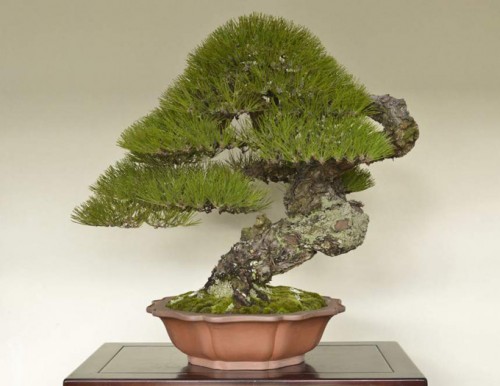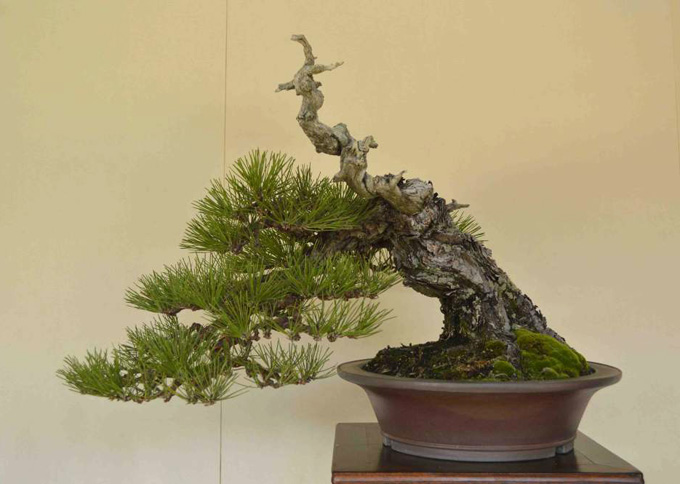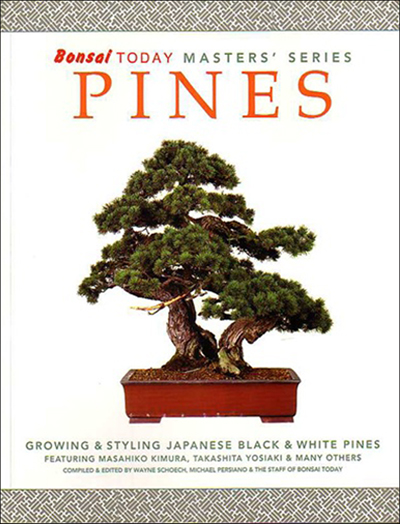 I’m going to guess that this peerless pine, with its strong sinuous trunk is a Japanese black pine, rather than a Japanese red. However, there’s no need to guess about the quality of the tree or where we found it (world-class quality and Bjorn Bjorholm’s website).
I’m going to guess that this peerless pine, with its strong sinuous trunk is a Japanese black pine, rather than a Japanese red. However, there’s no need to guess about the quality of the tree or where we found it (world-class quality and Bjorn Bjorholm’s website).
I don’t know exactly how this inexplicable oversight happened, but suffice it to say that I’m amazed and a little befuddled that we haven’t yet featured the truly remarkable bonsai on Bjorn Bjorholm’s website (Bjorvala Bonsai Studio) or the story of Bjorn’s apprenticeship in Japan. Especially given that Bjorn is practically from our own backyard (well, Tennessee isn’t exactly our backyard, but in this case, close enough), and given that they are such remarkable trees.
Just pines this time. I’m so taken with these trees that I’ve decided to make this a two part (or more) series. This first installment is devoted to pines. Next we’ll feature some of the equally impressive Shimpaku on Bjorn’s site. Maybe some others too.
I won’t say more, except encourage you to visit Bjorn’s website where you can view dozens of bonsai every bit as good as the ones shown here. You might also be interested in reading the story of Bjorn’s apprenticeship with Japanese bonsai Master Keiichi Fujikawa (though I don’t know this as fact, I’m imagining that all of the trees shown here reside at Mr Fujikawa’s Kouka-en nursery in Japan and that they are trees that Bjorn has had a hand in developing over the course of his long apprenticeship).
 Aging gracefully. A lovely old Japanese white pine with a soft and graceful feel.
Aging gracefully. A lovely old Japanese white pine with a soft and graceful feel.
 I don’t know exactly how big this sturdy little pine is, but it looks like it would qualify as a shohin. Anyway, I could say more, but I’ll step aside and let it speak for itself (except to say that you don’t see that much deadwood on pines and that I think the burnished Tokoname pot suits the tree quite well).
I don’t know exactly how big this sturdy little pine is, but it looks like it would qualify as a shohin. Anyway, I could say more, but I’ll step aside and let it speak for itself (except to say that you don’t see that much deadwood on pines and that I think the burnished Tokoname pot suits the tree quite well).
 If you hold your hand over the protruding trunk in the upper right, you’ll see a sweet little bonsai with a strong trunk and rounded crown. When you remove your hand, you’ll see a much more unusual tree, with a strong sudden trunk that completely doubles back on itself. Based on how the pines are sorted on Bjorn’s site, I know it’s either a Japanese black pine or a Japanese red pine. Based on the color of the trunk and the twigs, I’m going to guess that it’s a Japanese red (Pinus densiflora).
If you hold your hand over the protruding trunk in the upper right, you’ll see a sweet little bonsai with a strong trunk and rounded crown. When you remove your hand, you’ll see a much more unusual tree, with a strong sudden trunk that completely doubles back on itself. Based on how the pines are sorted on Bjorn’s site, I know it’s either a Japanese black pine or a Japanese red pine. Based on the color of the trunk and the twigs, I’m going to guess that it’s a Japanese red (Pinus densiflora).
 Our definitive Masters Series Pine Book is now on sale at Stone Lantern along with a complete selection of other bonsai books. You can learn about Japanese black and white pines with growing and styling lesson from many of the world’s greatest bonsai masters and by studying great photos of many of the best pines in the world.
Our definitive Masters Series Pine Book is now on sale at Stone Lantern along with a complete selection of other bonsai books. You can learn about Japanese black and white pines with growing and styling lesson from many of the world’s greatest bonsai masters and by studying great photos of many of the best pines in the world.
Wayne,
Not only is Bjorn awesome at Bonsai, he’s a pleasure to work with. I’d recomend anyone with a chance to do so take a workshop with him. He’s a great guy. And don’t forget the videos hes producing, “The Bonsai Art of Japan” on YouTube. Hands down the best bonsai videos around.
Thanks Ryan,
BTW: your comment prompted me to visit your website/blog. You’ve got some great pots up as usual and I like the shohin trees you put up recently.
Bjorn has some worked on some beautiful trees! He’s quite a talent!